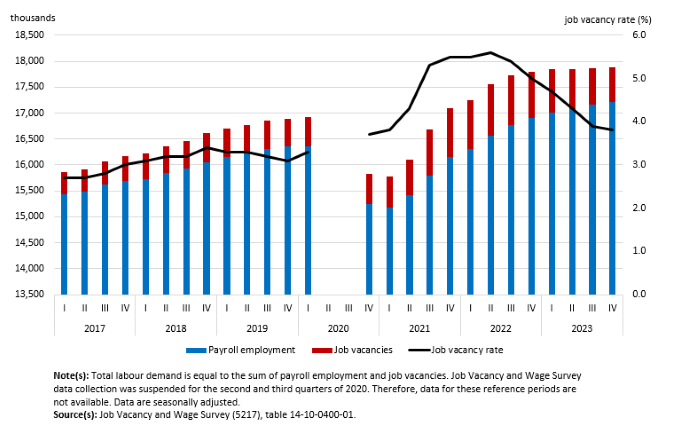Infographic 1
Job vacancies decrease in recent quarters as payroll employment increases

Infographic description
The title of the infographic is "Job vacancies decrease in recent quarters as payroll employment increases"
This is a linear and bar combination chart.
The vertical axis on the left shows the number of job vacancies and number of payroll employment in thousands, by increments of 500,000. It starts at 13,500,000 and ends at 18,500,000.
The vertical axis on the right shows the job vacancy rate by percentage, by increments of 1 percentage point. It starts at 0.0 and ends at 6.0.
The horizontal axis shows each quarter, from the first quarter of 2017 to the fourth quarter of 2023.
The dark red bar represents the number of job vacancies (in thousands) in the last 28 quarters, with 426,600 in first quarter of 2017, 430,700 in second quarter of 2017, 447,800 in third quarter of 2017, 485,100 in fourth quarter of 2017, 501,600 in first quarter of 2018, 516,800 in second quarter of 2018, 530,800 in third quarter of 2018, 566,400 in fourth quarter of 2018, 550,800 in first quarter of 2019, 548,300 in second quarter of 2019, 540,500 in third quarter of 2019, 530,600 in fourth quarter of 2019, 560,300 in first quarter of 2020, 584,600 in fourth quarter of 2020, 602,500 in first quarter of 2021, 690,300 in second quarter of 2021, 883,900 in third quarter of 2021, 940,100 in fourth quarter of 2021, 948,200 in first quarter of 2022, 983,600 in second quarter of 2022, 958,000 in third quarter of 2022, 882,800 in fourth quarter of 2022, 833,200 in first quarter of 2023, 767,800 in second quarter of 2023, 703,800 in third quarter of 2023, and 678,500 in fourth quarter of 2023.
The blue bar represents the payroll employment (in thousands) in the last 28 quarters, with 15,437,200 in first quarter of 2017, 15,489,600 in second quarter of 2017, 15,628,200 in third quarter of 2017, 15,685,900 in fourth quarter of 2017, 15,728,300 in first quarter of 2018, 15,837,000 in second quarter of 2018, 15,923,100 in third quarter of 2018, 16,050,500 in fourth quarter of 2018, 16,146,100 in first quarter of 2019, 16,216,300 in second quarter of 2019, 16,312,200 in third quarter of 2019, 16,364,500 in fourth quarter of 2019, 16,360,200 in first quarter of 2020, 15,237,900 in fourth quarter of 2020, 15,182,100 in first quarter of 2021, 15,418,100 in second quarter of 2021, 15,797,200 in third quarter of 2021, 16,153,200 in fourth quarter of 2021, 16,305,800 in first quarter of 2022, 16,566,700 in second quarter of 2022, 16,767,700 in third quarter of 2022, 16,909,400 in fourth quarter of 2022, 17,012,200 in first quarter of 2023, 17,079,200 in second quarter of 2023, 17,168,100 in third quarter of 2023, and 17,205,800 in fourth quarter of 2023.
The black line represents the job vacancy rate (in percentage) in the last 28 quarters, with 2.7% in first quarter of 2017, 2.7% in second quarter of 2017, 2.8% in third quarter of 2017, 3.0% in fourth quarter of 2017, 3.1% in first quarter of 2018, 3.2% in second quarter of 2018, 3.2% in third quarter of 2018, 3.4% in fourth quarter of 2018, 3.3% in first quarter of 2019, 3.3% in second quarter of 2019, 3.2% in third quarter of 2019, 3.1% in fourth quarter of 2019, 3.3% in first quarter of 2020, 3.7% in fourth quarter of 2020, 3.8% in first quarter of 2021, 4.3% in second quarter of 2021, 5.3% in third quarter of 2021, 5.5% in fourth quarter of 2021, 5.5% in first quarter of 2022, 5.6% in second quarter of 2022, 5.4% in third quarter of 2022, 5.0% in fourth quarter of 2022, 4.7% in first quarter of 2023, 4.3% in second quarter of 2023, 3.9% in third quarter of 2023, and 3.8% in fourth quarter of 2023.
Note(s): Total labour demand is equal to the sum of payroll employment and job vacancies. Job Vacancy and Wage Survey data collection was suspended from April 2020 to September 2020. Therefore, data for these reference periods are not available. Data are seasonally adjusted.
Source(s): Job Vacancy and Wage Survey (5217), table 14-10-0400-01.
- Date modified: